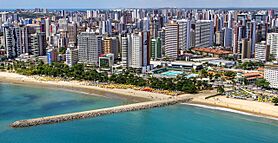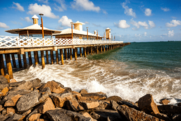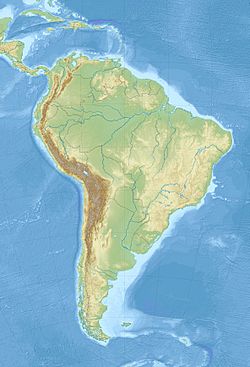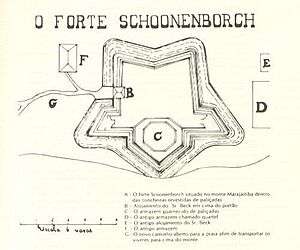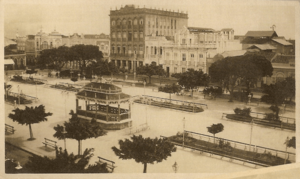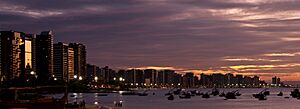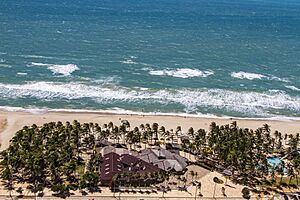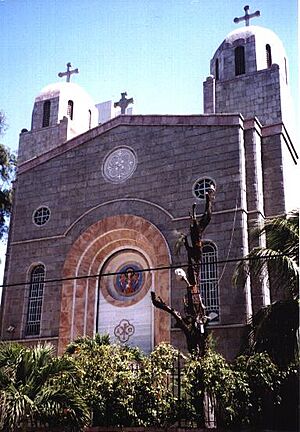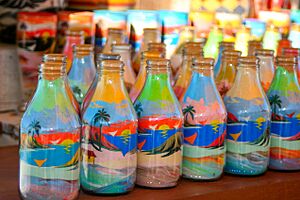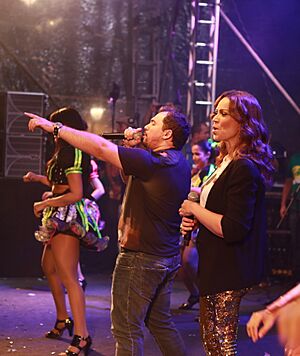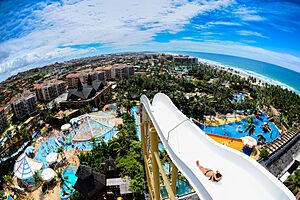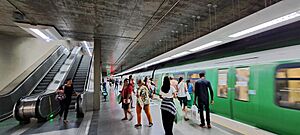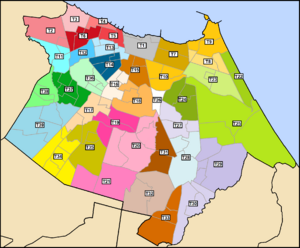Fortaleza facts for kids
Quick facts for kids
Fortaleza
|
|||
|---|---|---|---|
|
Municipality
|
|||
| Municipality of Fortaleza Município de Fortaleza |
|||
|
Skyline of Fortaleza with the Meireles Beach
Dragão do Mar Center of Art and Culture
Theatre José de Alencar
English Bridge
St. Joseph's Cathedral
Castelão Stadium
Statue of Iracema
|
|||
|
|||
| Nicknames:
Fortal
Miami Brasileira (Brazilian Miami) Terra da Luz (Land of Light) |
|||
| Motto(s):
"Fortitudine" (Latin)
|
|||
 |
|||
| Country | |||
| Region | Northeast | ||
| State | |||
| Founded | 13 April 1726 | ||
| Government | |||
| • Type | Mayor-council | ||
| Area | |||
| • Municipality | 312.353 km2 (120.600 sq mi) | ||
| • Metro | 7,440.053 km2 (2,872.621 sq mi) | ||
| Elevation | 16 m (52 ft) | ||
| Population
(2022)
|
|||
| • Municipality | 2,428,708 | ||
| • Rank | 4th | ||
| • Density | 8,654.92/km2 (22,416.1/sq mi) | ||
| • Metro | 3,903,945 | ||
| • Metro density | 560.21/km2 (1,450.9/sq mi) | ||
| Demonym(s) | Portuguese: Fortalezense | ||
| GDP (PPP, constant 2015 values) | |||
| • Year | 2023 | ||
| • Total (Metro) | $39.6 billion | ||
| • Per capita | $10,600 | ||
| Time zone | UTC−3 (BST) | ||
| Postal code |
60000-001 to 61599-999
|
||
| Area code | +55 85 | ||
| HDI (2010) | 0.754 – high | ||
Fortaleza is a big city in Brazil. It is the capital of the state of Ceará. You can find it in the northeastern part of Brazil.
Fortaleza is the 4th largest city in Brazil. About 2.4 million people live there. If you include the areas around it, almost 4 million people call it home.
The city is a major center for industry and trade in Northeast Brazil. It is also a very popular place for tourists to visit. In fact, it's the fourth most visited city in the country!
Fortaleza is close to the Atlantic Ocean. It's also an important port for trade. It is the closest major port in Brazil to Europe. People who live in Fortaleza are called Fortalezenses.
Contents
- History of Fortaleza
- Geography and Nature
- People of Fortaleza
- Economy of Fortaleza
- Culture of Fortaleza
- Fun Things to Do in Fortaleza (Tourism)
- Education in Fortaleza
- Getting Around Fortaleza (Transportation)
- Sports in Fortaleza
- City Areas
- Famous People from Fortaleza
- Fortaleza's Sister Cities
- Images for kids
- See also
History of Fortaleza
Early Days and Forts
The story of Fortaleza began in 1603. A Portuguese explorer named Pero Coelho de Souza built a fort called São Tiago. He also started a small town called Nova Lisboa. Later, another Portuguese leader, Martins Soares Moreno, made the fort bigger. He changed its name to Forte de São Sebastião.
In 1630, the Dutch came to Brazil. They took over the Fort of São Sebastião in 1637. But in 1644, the fort was destroyed in battles.
A new fort was built by the Dutch in 1649. They called it Fort Schoonenborch, which means "graceful stronghold." In 1654, the Dutch gave the fort back to the Portuguese. The Portuguese renamed it Fortaleza da Nossa Senhora de Assunção. This long name means "Fort of Our Lady of the Assumption." This is where the city of Fortaleza gets its name!
Fortaleza officially became a village in 1726. In 1799, it became the capital of the state of Ceará.
Growing as a City
During the 1800s, Fortaleza grew a lot. This was helped by the cotton industry. The city became a key place for sending goods to other countries. It also started direct shipping routes to Europe. A customs building was built in 1812 to handle all the trade.
In the 1930s, new areas like Messejana and Porangaba became part of the city. The first university in Fortaleza, the Universidade Federal do Ceará, opened in 1954. By the 1980s, Fortaleza had grown to be the second largest city in Northeast Brazil. Today, it is the 4th largest city in the country.
Geography and Nature
Fortaleza's Climate
Fortaleza has a typical tropical climate. This means it's warm all year round. The air is also quite humid. But nice winds from the ocean usually make it feel comfortable.
The average temperature is around 27.0 degrees Celsius (80.6 degrees Fahrenheit). The city has a rainy season from January to July. March and April get the most rain. From August to December, it's usually very dry with little rain.
Plants and Animals

Fortaleza has plants that grow near the coast. You can find mangrove forests in some protected areas. These are especially near the mouths of the Ceará, Cocó, and Pacoti rivers.
The city has seven special areas to protect nature. One of the most important is the Cocó Park. It's one of the largest urban parks in Latin America. The Cocó River runs through it. This river's mangrove areas are home to many animals. These include mollusks, crustaceans, fish, reptiles, birds, and even some mammals. The park has trails and offers activities to learn about nature.
The Pacoti River provides much of the water for Fortaleza. The area where the Ceará River meets the ocean is also a protected zone.
People of Fortaleza
Population and Diversity
Fortaleza is home to over 2.4 million people. Most people in Fortaleza are of mixed heritage, called Pardo (60%). About 32.7% are White, and 7% are Black. There are also small numbers of Asian and Amerindian people.
The city is part of a larger metropolitan area. This area includes cities like Caucaia and Maracanaú. Together, they form a big community.
Religions in Fortaleza
Most people in Fortaleza are Roman Catholic. About 67.88% of the population follows this religion. Many people are also Protestant, making up about 21.35% of the population. Some people have no religion, and smaller groups follow other faiths.
Economy of Fortaleza
Fortaleza has a strong economy. It has the largest GDP in the Northeast Region of Brazil. This means it produces a lot of goods and services.
The main part of Fortaleza's economy is the service sector. This includes things like shops, restaurants, and other services. The industrial sector, which makes products, is also very important. Many people in Fortaleza have jobs in these areas.
Culture of Fortaleza
Fortaleza has a rich culture. The city works to protect its historical buildings and places.
Arts and Entertainment
Fortaleza has many theaters. Some of the most famous are Theatro José de Alencar and São Luiz Cinema Theater. The Dragão do Mar Center of Art and Culture is a major cultural hub. It has museums, theaters, a planetarium, and cinemas. It's a great place for public events and learning.
The Ceará Museum shows many old items and furniture. The Casa de Jose Alencar is a museum about Brazilian literature. It has art, a library, and historical ruins.
Handicrafts and Fashion
Handicrafts are very popular in Fortaleza. You can find many handmade items, especially those made with colored sand. Places like the Ceará Craft Center (CeArt) are great for finding these unique products.
Fortaleza is also a big center for fashion and textiles. Many clothes are made here. Events like Dragão Fashion Brasil showcase the latest designs.
Music and Carnival
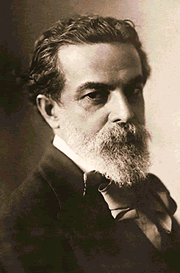
Forró is the most popular type of music in Fortaleza. Bands from the city have helped make electronic forró famous. This style mixes traditional forró with pop music.
Fortaleza also has a strong tradition in classical music. Alberto Nepomuceno was a famous composer from the city. He is known as the "founder of Brazilian music."
The city hosts one of Brazil's well-known Carnivals. People celebrate with music and dancing, especially at Iracema Beach.
Local Food

The food in Fortaleza is similar to other Northeastern Brazilian dishes. A common dish is baião de dois, which is rice and beans. It's often eaten with grilled lamb or sun-dried meat. Tapioca pancakes, made from cassava starch, are also very popular.
Seafood is a big part of the local food. You can enjoy dishes like fish stew (moqueca) and grilled mackerel. Crab, shrimp, and lobster are also widely used in many tasty meals.
Fun Things to Do in Fortaleza (Tourism)
Fortaleza is a top spot for tourists. It has about 25 kilometers (15 miles) of city beaches.
- Beaches: Praia de Iracema and Futuro Beach are very popular. You can find bars, restaurants, and music clubs along Avenida Beira Mar.
- Water Parks: The Beach Park is a huge water park nearby. It's one of the largest in Latin America.
- Jangadas: At Mucuripe, you can see traditional fishing boats called jangadas. Fishermen still use them. You can watch them go out to sea in the afternoon and return with their catch in the morning. Some of the fresh fish is sold at a local market.
- Scuba Diving: If you like diving, you can explore the Pedra da Risca do Meio Marine State Park. It's a protected area about 10 nautical miles from the coast.
Education in Fortaleza
Fortaleza has made big improvements in education. More and more people are finishing school. The Federal University of Ceará, located in Fortaleza, is one of the best universities in Brazil.
Getting Around Fortaleza (Transportation)
Fortaleza Airport
The Pinto Martins – Fortaleza International Airport is located in the city center. It's a very busy airport, especially in Northeast Brazil. It has been expanded to handle many more passengers. It welcomes thousands of international and domestic flights each year.
Roads and Bikes
Fortaleza has many cars and motorcycles. The city also has a good network of bike lanes, totaling about 116.4 kilometers (72 miles). There's even a public bicycle system called Bicycletar.
Buses are a main way to get around the city. The bus system is called the Integrated Transportation System (SIT-FOR).
Subway System
Fortaleza has a subway system called MetroFor. It has five lines and helps people travel across the city quickly. The subway started running in 2014.
Sports in Fortaleza
Fortaleza is a big city for sports, especially soccer. It hosts many games for the Ceará State Championship. The city has several popular soccer clubs, like Ceará SC and Fortaleza EC.
Fortaleza was also one of the cities that hosted games for the 2013 FIFA Confederations Cup and the 2014 FIFA World Cup.
City Areas
Fortaleza is divided into 121 neighborhoods. These neighborhoods are grouped into 39 administrative areas. These areas are managed by 12 subprefectures.
Some well-known neighborhoods include:
- Dom Lustosa
- Parangaba
- Pirambu
- Praia de Iracema
- Rodolfo Teófilo
Famous People from Fortaleza
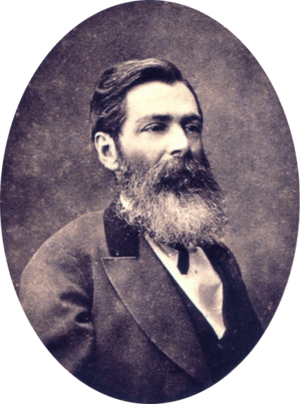

Many notable people come from Fortaleza, including:
- José de Alencar, a famous writer from the 1800s.
- Alberto Nepomuceno, a well-known composer.
- Rachel de Queiroz, the first woman writer to join the Brazilian Academy of Letters.
- André Diamant, an international chess grandmaster.
- Casimiro Montenegro Filho, who helped start the Brazilian Air Force Aeronautical Technologic Institute.
- Márcio Araújo and Shelda Bede, Olympic medalists in beach volleyball.
- Many professional footballers like Evanilson and Mário Jardel.
- Mixed martial arts professionals like Thiago Alves.
Fortaleza's Sister Cities
Fortaleza has special connections with other cities around the world. These are called "sister cities":
 Ferreira do Alentejo, Portugal
Ferreira do Alentejo, Portugal Lisbon, Portugal
Lisbon, Portugal Miami Beach, United States
Miami Beach, United States Montese, Italy
Montese, Italy Praia, Cape Verde
Praia, Cape Verde Racine, United States
Racine, United States Sal, Cape Verde
Sal, Cape Verde
Images for kids
-
Windsurfing in Fortaleza
See also
 In Spanish: Fortaleza (Brasil) para niños
In Spanish: Fortaleza (Brasil) para niños


